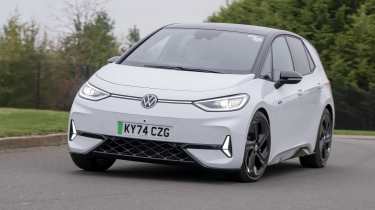Volkswagen ID.3 GTX Performance 2025 review – an electric Golf GTI?
The GTX badge has been applied to the ID.3 in efforts to bring a sharper drive to Volkswagen’s smallest EV. We find out if it’s pulled it off
With the Alpine A290 and Abarth 600e recently launching with promises of hot hatch performance in an all-electric package, whether or not that’s really within reach is a hot topic. The ID.3 GTX is perhaps the pinnacle of this debate, with Volkswagen boldly launching it as an ‘electric counterpart’ to its iconic Golf GTI.
Look past its high price tag and the ID.3 GTX is more promising than most of its rivals on-paper, with drive to the rear, a strong power output and a truly usable range courtesy of a new and improved battery pack. Whether or not this makeover has finally made the ID.3 a driver’s car, though, is what we’re about to find out.
> Alfa Romeo Junior Veloce 2024 review – a driver’s EV on a budget
Under its lightly modified skin is a new and enlarged underfloor 84kWh (79kWh useable) battery pack, sending power to an optimised rear-mounted motor for a punchy 318bhp output (while not sold in the UK, a non-Performance ID.3 GTX is available with 282bhp in other markets) – torque stands at a stout 402lb ft, almost 100lb ft ahead of a Golf R. The 429bhp MG4 XPower is the only car in its class to have more power, and while it’s also significantly cheaper than the Volkswagen, it certainly wouldn’t be our choice from a driver’s standpoint.
More reviews
Given it lacks the power and all-wheel drive of its Chinese rival, the ID.3’s 0-62mph time suffers at 5.7sec, quite some way from the 3.9sec of the MG4. In reality though, this disparity is far less of an issue, with the GTX Performance rapid from a standstill and low-speed roll, largely thanks to its rear-drive setup (and subsequent traction advantage) and chunky torque figure. Throttle response is sharp in its most aggressive setting, but opt for Eco mode and it’s just as measured as you’d hope. Pull tails off once you reach the national speed limit, but the same can be said for every one of its rivals.
While drive to the rear has its traction benefits over front-wheel drive, it gives the ID.3 GTX a less playful edge than the likes of the Abarth 600e and Alfa Romeo Junior Veloce. These two Stellantis rivals boast a Torsen mechanical limited-slip differential on the front axle, and while their outputs are lower than the ID.3, this gives them some real adjustability on the limit, and makes them considerably more engaging as a result. Push on to find the limit of traction in the ID.3 GTX and you’ll find stability control cutting in far before the fun begins, making it feel softer edged and much more restrictive.
Where the ID.3 GTX does stand ahead of its rivals, though, is its range. Despite the performance on offer, a huge 84kWh battery pack (79kWh useable, 28kWh more than that in the Abarth 600e) and claimed 4.4-mile/kWh efficiency figure liberates a huge WLTP combined range of 369 miles, making the c200-mile estimate of Stellantis’s performance offerings laughable. As we’ve come to expect though, a huge battery comes at a price.
While the (admittedly slightly smaller) Abarth 600e and Alfa Romeo Junior Veloce stand at just over 1600kg, the ID.3 GTX weighs in at a portly 2000kg, 200kg more than even the all-wheel drive MG4 XPower. That means that despite a 42bhp power advantage over the Abarth and Alfa, its power-to-weight figure is actually over 10bhp/ton down on these cheaper rivals. Not only does this have an impact on urgency on the move, it also has a significant impact on the ID.3’s ride.
In the UK with the GTX Performance you get adaptive DCC damping as standard to help compensate, but there’s no hiding the ID.3’s weight. While there’s a noticeable improvement in body control and response over the standard ID.3, it still struggles to manage its mass on trickier tarmac, lurching over bumps and never quite settling to give you the confidence you’d expect from an electric GTI – on the wrong road, the ID.3 GTX feels as tall and ungainly as it looks. The adaptive damping does offer a good spread of adjustability for secondary ride, but it doesn’t solve the underlying dynamic flaws. Brakes are well calibrated on the whole, with the dreaded step between regen and friction braking hard to discern unless you look for it.
It’s a similar story with the steering, as while the thin wheel helps provide a greater sense of feedback than you’d have otherwise, off-centre response and weighting both have room for improvement, with true feedback virtually non-existent. For the everyday driver, the neat red piping and tight turning circle will be a plus, but the ID.3 GTX is not the electric GTI you might expect.
The GTX continues the black and red theme across the cabin, with bland but supportive GTX-branded sports seats standard and upholstered in recycled fabric. The door cards and dash feature a soft touch leather material for a premium touch, making the airy, minimalist cabin a pleasant place to be, if not one that quite matches its high price tag. A sharper 12.9-inch ChatGPT-equipped central infotainment display is carried across from the standard range, as is the distinct lack of physical controls – the only physical buttons in the cabin are for start/stop, hazards and the SOS function.
Until recently with the introduction of Stellantis’s e-CMP-based performance EVs, it’s been a given that any model in this class would look a little compromised in terms of design in the pursuit of efficiency. Given its impressive range, this does seem to have paid off in the ID.3’s case, but whether it’s worth the aesthetic trade off is another matter. While the GTX receives a new, lightly modified front bumper with more angular intakes, a new ‘diffuser’, side sills, daytime running lights a black roof, it doesn’t shake standard car’s awkward, tall proportions. Stack it side-by-side with an Abarth 600e or Alfa Romeo Junior Veloce and the purposeful stance and eye-catching design elements of those cars is lacking.
Price, specs and rivals
At £46,225, the Volkswagen ID.3 GTX Performance is not a cheap option in 2024, with many of its rivals coming in at far below that figure. Granted, it has a claimed range of a car from the class above, and the standard fitment of DCC adaptive damping is nice to have, but when the MG4 XPower offers over 100bhp more for almost £10,000 less, it’s a hard sell. If you like the sound of the ID.3 but are looking for some Spanish flair, though, the Cupra Born VZ offers the same underpinnings for £1600 less.
The Abarth 600e and Alfa Romeo Junior Veloce are some of the most engaging cars in the class thanks to their mechanical limited-slip differentials and comparatively low weight figures, and both cost less than the ID.3 at £41,975 and £42,295 respectively. Nevertheless, range is certainly not on their side at around 200 miles.
These models aside, there aren’t many direct rivals to choose from. If larger dimensions aren't an issue for you though, the Tesla Model 3 is an attractive alternative, costing £1235 less at £44,990 for the Long Range Rear-Wheel drive while boasting an even more impressive 436-mile range and an eight tenth improvement in 0-62mph time.
Volkswagen ID.3 GTX Performance specs
| Powertrain | Single-motor, rear-wheel drive |
| Battery | 84kWh (79kWh useable |
| Power | 318bhp |
| Torque | 402lb ft |
| 0-62mph | 5.7sec |
| Top speed | 124mph |
| Weight | 2000kg |
| Power-to-weight | 159bhp/ton |
| Range (WLTP combined) | 369 miles |
| Price | £46,225 |



